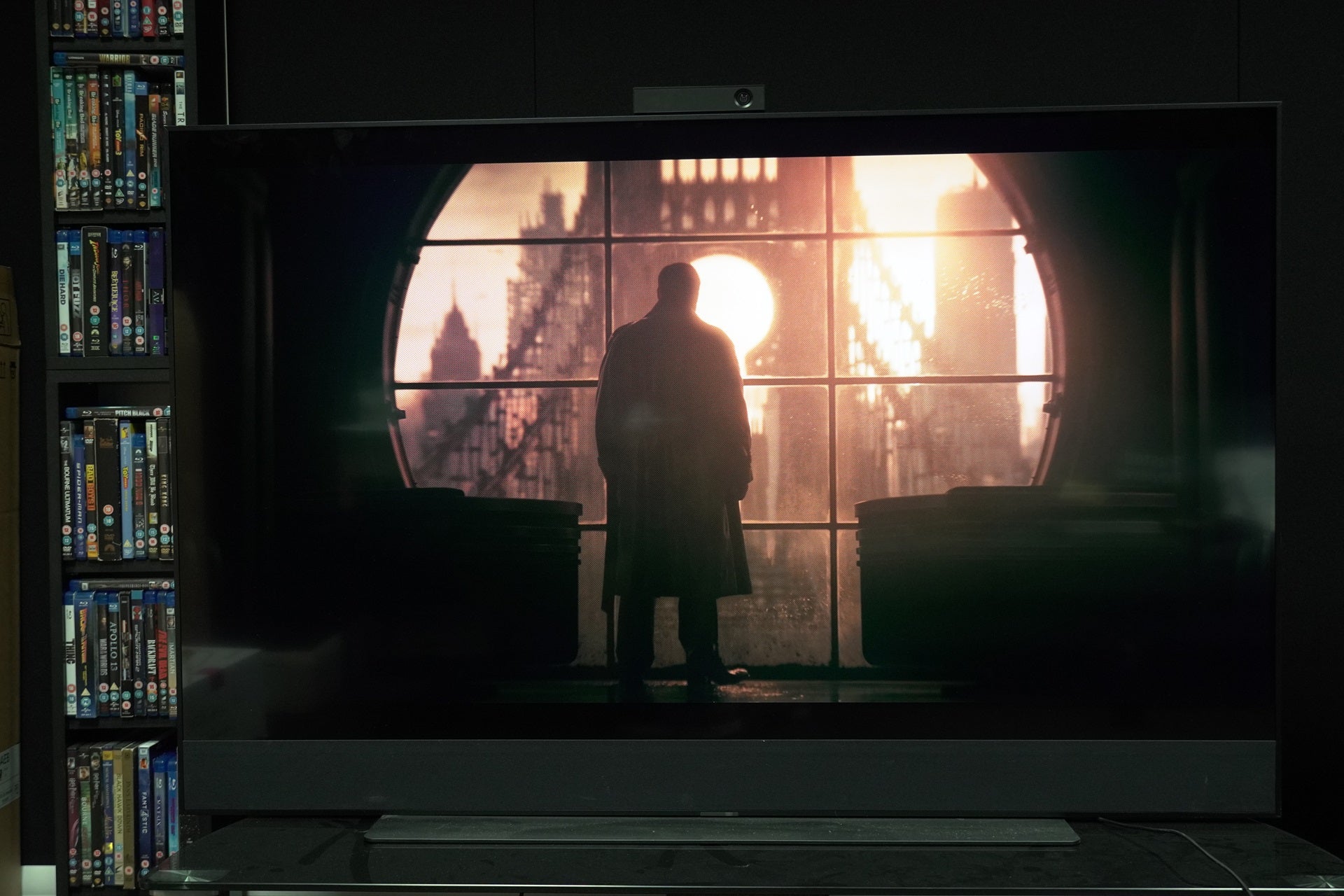Verdict
Consider Sky Glass for what it is than what it’s not. The interface is greatly accessible, the Vivid mode improves the HDR performance, and it sounds decent too. Sky Glass fulfils a more of its potential to just about earn a recommendation but its showing its age against newer 4K TVs.
Pros
- Great content library
- Decent sound for a TV
- Vivid mode improves HDR performance
- Constantly improving through updates
Cons
- Weak viewing angles
- Only three HDMI inputs
- Add-ons add to the expense
- Inconsistent backlighting
Sky Glass
Sky Glass can be had from £699 Upfront cost
- Sky
- Sky Glass
- £699 Upfront
View Deal
-
Entertainment OSEverything Sky has to offer alongside the likes of Netflix, Disney+ et al -
SoundBuilt-in Dolby Atmos speaker system -
HDR supportHLG, HDR10 and Dolby Vision
Introduction
Sky Glass smooths the edges of the TV buying experience by taking care of picture, sound, and content without the need for additional soundbars, set-top boxes or streaming sticks.
When Sky Glass first launched the reception was mixed. For all its promise its HDR performance was lacklustre. Considering the wealth of content on the Sky platform, there’s not much point in watching if it looked bang average.
Since then Sky has rolled out the improvements, with over 500 updates since Glass launched. Is it now a TV worthy of being in your living room? Well, after giving it another look for a few days, it’s complicated.
Availability
Sky Glass can be purchased either from Sky or from Currys in the UK. Sizes come in 43-, 55- and 65-inches. The TV can be bought outright (£699, £949, and £1199); or in monthly 24- and 48-month instalments.
If you buy outright the cost has gone up since Glass first launched. The 43-inch model is £50 more, the 55-inch is £100 more expensive, and the 65-inch model is £150 pricier.
Prices as of November 2024 were as low as £14/month + additional fees on a 48-month contract for the 43-inch model.
The Sky Live camera is available as a bundle with Glass. That starts at £20/month for three months, and £46/month thereafter on a four-year contract for the 43-inch TV. It’s £25/month for the 55-inch and £30/month for the 65-inch model.
If you have Glass then Sky Live is an extra £6/month (48-month contract), or it can be bought outright for £290.
In terms of add-ons, customers can choose the Ultra HDR and Atmos package to Sky Sports, Sky Cinema, multi-room, the Sky Stream puck and more.
Design
- Heavy
- Minimalist looks
- Several colour options
Viewed head-on and I’d describe Sky Glass as elegant: its thin bezel trim, anodised finish, and acoustic speaker mesh grille give it an understated but classy appearance.


But Glass is also a hefty unit with a depth of 477mm. The 55-inch model weighs 28kg so it’s a relief that installation is performed by the courier service. Just putting it on the stand takes two people in our testing room. If you want to wall-mount, give Sky a call and they’ll do it for you.
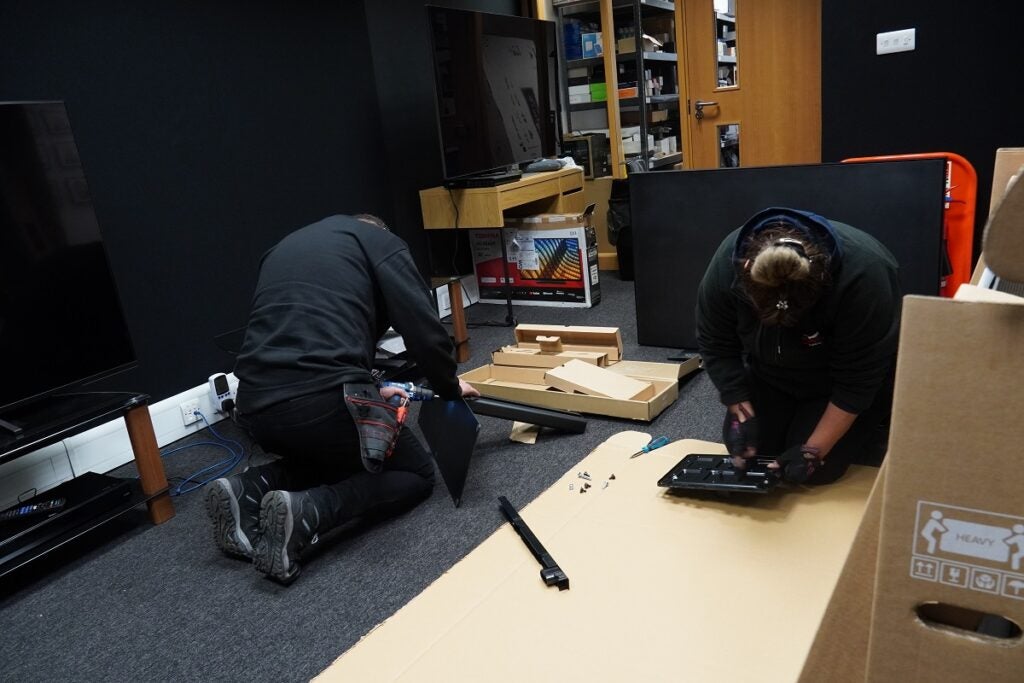

The review sample is black Anthracite, but Sky Glass brings colour to a room with a choice of blue, white, green and pink to match your décor. The speaker grille can be customised with magnetised attachments, which are available from Amazon seller Concino Limited (£39.99 to £59.99 depending on the size).


On the right-hand side are two buttons, one for disabling the TV’s far-field microphones and another for power. The top of the screen features a perforated acoustic grille (similar to a Samsung 8K TV) that allows audio to be dispersed from the upfiring speakers.
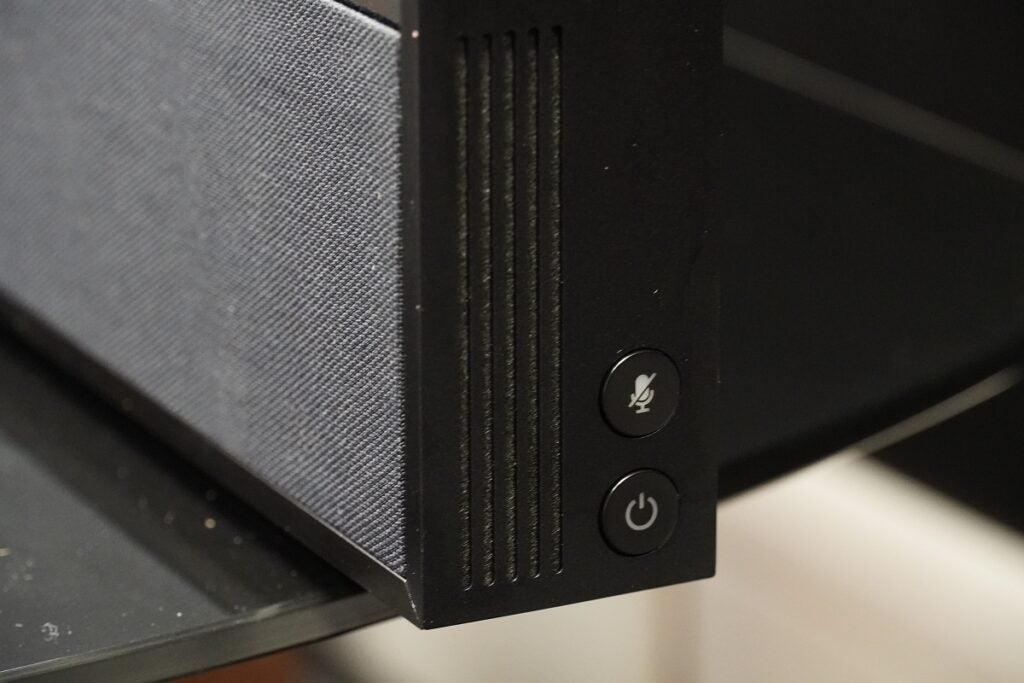

Operating System
- Personalised playlists
- Easy to use interface
- Sky’s voice control
Entertainment OS aggregates all Sky has to offer alongside content from other services. It uses the same rail navigation system as Sky Q, with the top rail offering quick access to recently used apps, inputs and spotlighted content in Top picks.


The rail below is divided into TV Shows, Movies, Sport, Kids, Audio and Music, News, Fitness and International. Each section keeps the same look with content listed in rows and TV guides specific to each one. The genre rails below are personalised based on your viewing history. Title pages have been given a spruce up with more information at hand such as fan reviews ratings and a Rotten Tomatoe score.


Most Sky Q apps make their way to Glass but the overall number is fewer than the likes of Samsung’s Tizen, LG’s webOS or Google TV. Since Sky Glass launched its added Apple TV+, Peacock, HayU, U, My5, and Paramount+.
Flicking through the rails with the remote is swift and lag isn’t usually an issue (but there are times where the ‘please wait’ icon hovers for a while). The remote is a neat affair with a grippy hold and backlit buttons for use when the lights are down. It attracts fingerprints and smudges, but they’re easily wiped off.
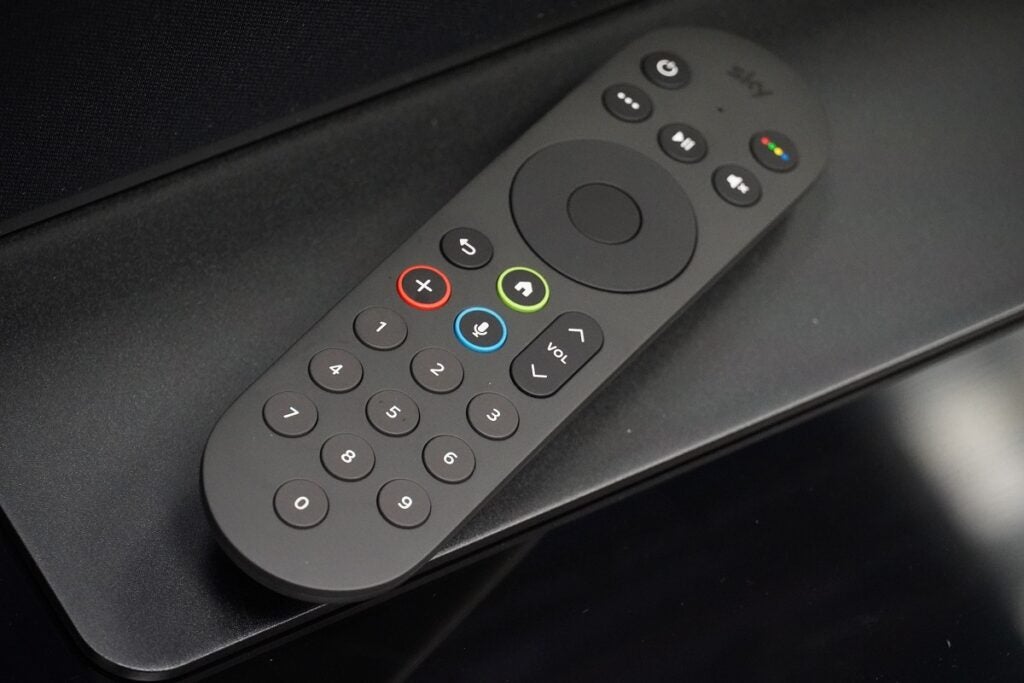

If you don’t want to use your digits, there’s built-in voice control initiated by the words ‘Hello Sky’. Voice support has been added to the likes of YouTube, Netflix, Amazon Music and ROXi.
Voice commands via the remote’s near-field mic don’t require the ‘Hello Sky’ prompt, and in general, voice control more or less gets you where you want or to what you’re after. At a loss for what to watch? Say “What should I watch?” and you’re served rows of recommended titles. Want to rewind or fast-forward with your voice? That Sky Q feature has made its way to Glass.
Sky refers to its Playlist feature as cloud DVR but you can’t record content. What is does is collate the content you’re watching and plan to watch. It’s a great way to keep track of shows and films. There are no individual profiles but there are personalised Playlists for different family members (up to five).


However, for those who prefer to keep their titles permanently, or at least for several months, that’s not possible due to rights issues. Once a programme has left Netflix, it will disappear from your Playlist. Sky’s counterargument is that nothing truly disappears but packs up its bags and moves to another service; but that means having a subscription for each service, which is inconvenient.
You also can’t add content to Playlist directly from apps. If you come across something of interest outside of an app, press the ‘+’ button to add it to your Playlist. It’s a nice and straightforward action.
Add a TV series to Playlist and it’ll string together all the seasons, regardless of the apps it’s spread over and if it’s not available elsewhere the Sky Store fills the gap.
You can add an actor though its implementation confuses me – it doesn’t add the entire actor’s work. Say, for example, you’re on the Game of Thrones’ title page and you ‘add’ Emilia Clarke to the Playlist and what you’ll actually be adding is Game of Thrones or even removing it if you’ve previously added it. At other times, trying to add an actor comes up with “Sorry, we can’t add this to the Playlist” message.


Sky says there’s a ‘People you follow’ rail within Playlist, but if it’s there, I can’t see it.
Where accessibility is concerned, Sky has incorporated the High Contrast interface, Audio description and highlighting of content in the TV Guide for easier recognition.
Features
- New Auto Game mode
- Three HDMI inputs
- Low Latency broadcast delay for Sky Sports
Glass supports gaming through its built-in portal and Sky Live, but it’s made a stab at being a better gaming TV for PS5 and Xbox Series X gamers through a new Auto Game Mode via the addition of ALLM to the TV.
That sounds like good news but I can’t manually activate the game mode, and latency has gone up from 66ms to 82ms. Glass still lacks premium features such as 4K/120Hz or VRR to make it appealing as a gaming monitor.
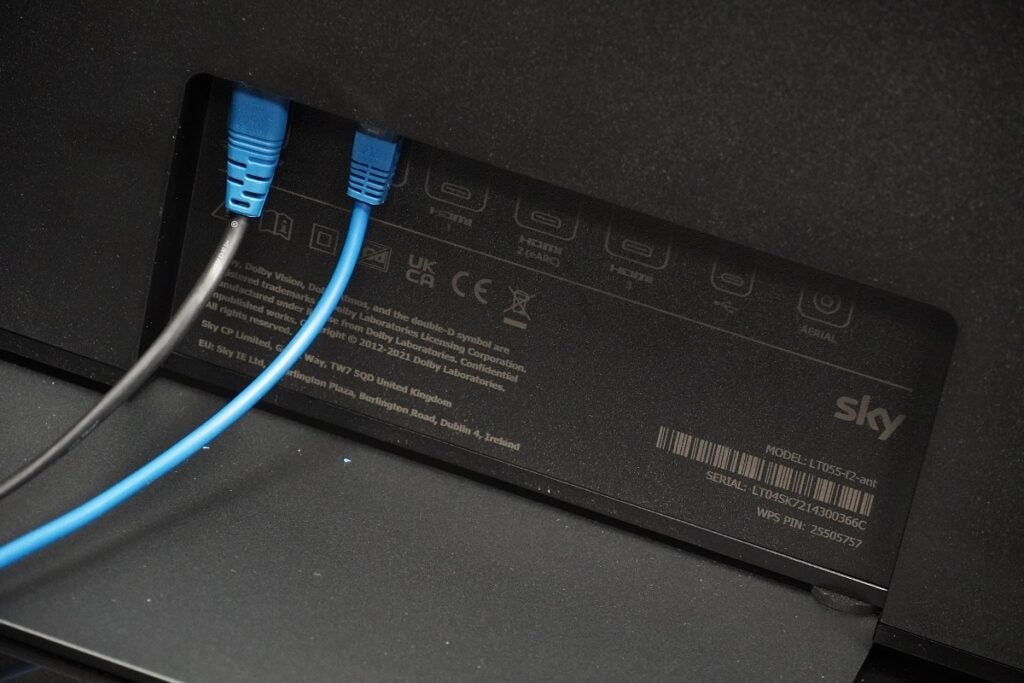

The three HDMI inputs support the HDMI 2.1 spec, with HDMI 2 the eARC port for pass-through of higher quality audio to an external sound system. Other connections include USB-C, Ethernet, and a DTT DVB-T/T2 aerial. The aerial offers basic Freeview and acts as a backup if the Internet goes down.
There’s Bluetooth 5.0 (for the remote, and connecting other devices) and Wi-Fi 6. Sky Glass requires a minimum speed of 10Mb/s (25Mb/s for 4K Ultra HD).


During start-up you’re given a choice of Default or Enhanced experiences. Enhanced activates voice control and the instant wake-up features, so the TV can be turned on via voice or by walking past, though I’ve not found it to be the most consistent in its behaviour.
Sky Sports Main Event viewers can opt in to watch sports in Low Latency, reducing the broadcast delay by 22 seconds. It’ll be coming to other Sky Sports channels before the end of 2024.
Sky Live
- Support for Zoom video calls
- Body tracking
- Watch Together experience with others
Sky Glass supports an interactive smart camera called Sky Live. It can be purchased in a bundle with the Glass, and while it’s an accessory, it’s been designed to take advantage of what Glass can offer.


There’s a magnetic connection on top of the screen where the camera attaches to. It occupies one HDMI port of the three included plus a USB-C connection. That’s inconvenient if you’re already using these inputs.
Like Glass itself, Sky Live’s purpose is multi-faceted. The camera can be used for Zoom chats, or Watch Together parties. It can track workouts with the Mvmnt fitness app track your movements with games. You can even see other players online with the likes of Monopoly.


It’s a promising device, but I wouldn’t say that it’s a must buy. It’s geared towards families and in that regard it works well. The camera is very good at keeping track of where you are; The games are fun and tiring (Cone Knockout is a genuine workout), although the tracking can be iffy, either not reading your input or too eager to do so.
Picture quality on a Zoom call is grainy and noisy on a full screen despite the camera’s 4K resolution; and voice capture is better closer to the camera than from afar. While I understand the use case, a video call on a smartphone is more convenient.
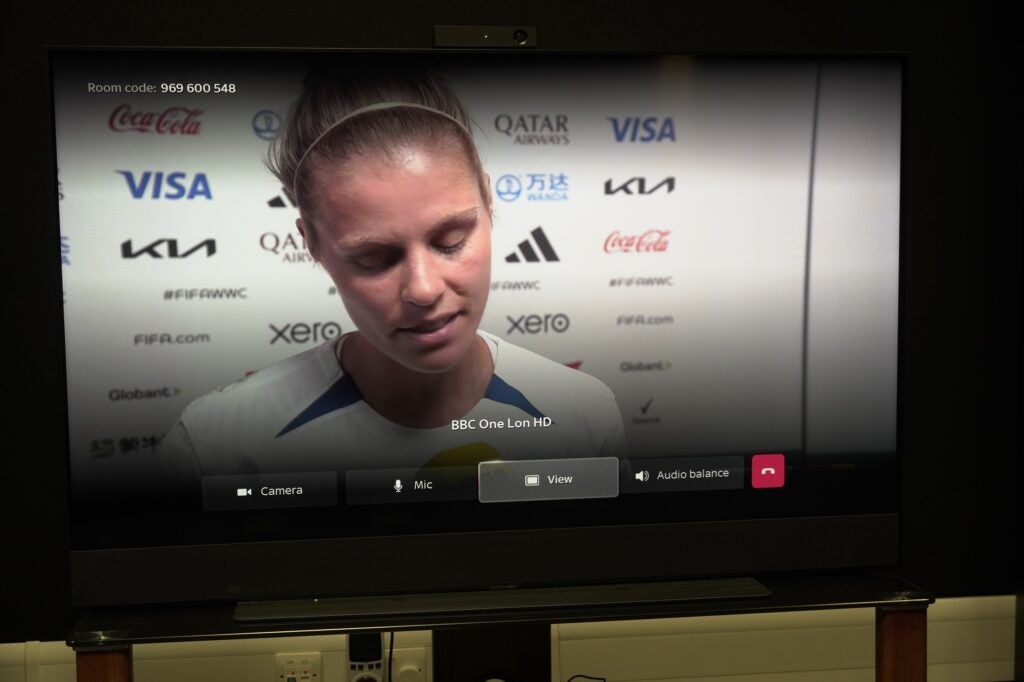

Watch Together is a solid experience but the balance between voice pick-up and what you’re watching on screen could be handled better. It’s boring to say that Sky Live is a device with potential, but it is exactly that.
It is technically proficient, but outside of young families, I can’t see a reason for anyone purchasing Sky Live. And as Sky Live doesn’t work without Glass, to get the camera is to purchase the TV as well.
Picture Quality
- Not the sharpest image
- Improved brightness and colours with Vivid mode
- Weak viewing angles
At launch Sky Glass’s picture quality was no disaster, but it certainly was not as good as it could have been.
The biggest issue was its HDR performance, which lacked brightness and colours that looked washed out. The gap between it and more recent TVs has only worsened in the years since its launch.


I measured brightness with a 5% HDR window on the 55-inch model at 430 nits. Compare Glass to more recent QLED TVs such as the Samsung Q80D and that model easily hits 1000 nits. There are times when HDR content looks like it isn’t in HDR with Glass. The picture lacks punch, saturation, and contrast.
Sky has since added a Vivid that ups the level of peak HDR brightness by hitting 566 nits on 5% window and 670 nits on a 10% window. It’s still not up to the level of the Q80D, or Mini LED TV such as the QN90D, which hits 2000 nits, but it does bring improvements to the picture.
The Vivid mode adds more colour and saturation to images. It’s there to see in the striking opening credits of Elvis – reds are bolder in their appearance and the golds actually look golden.
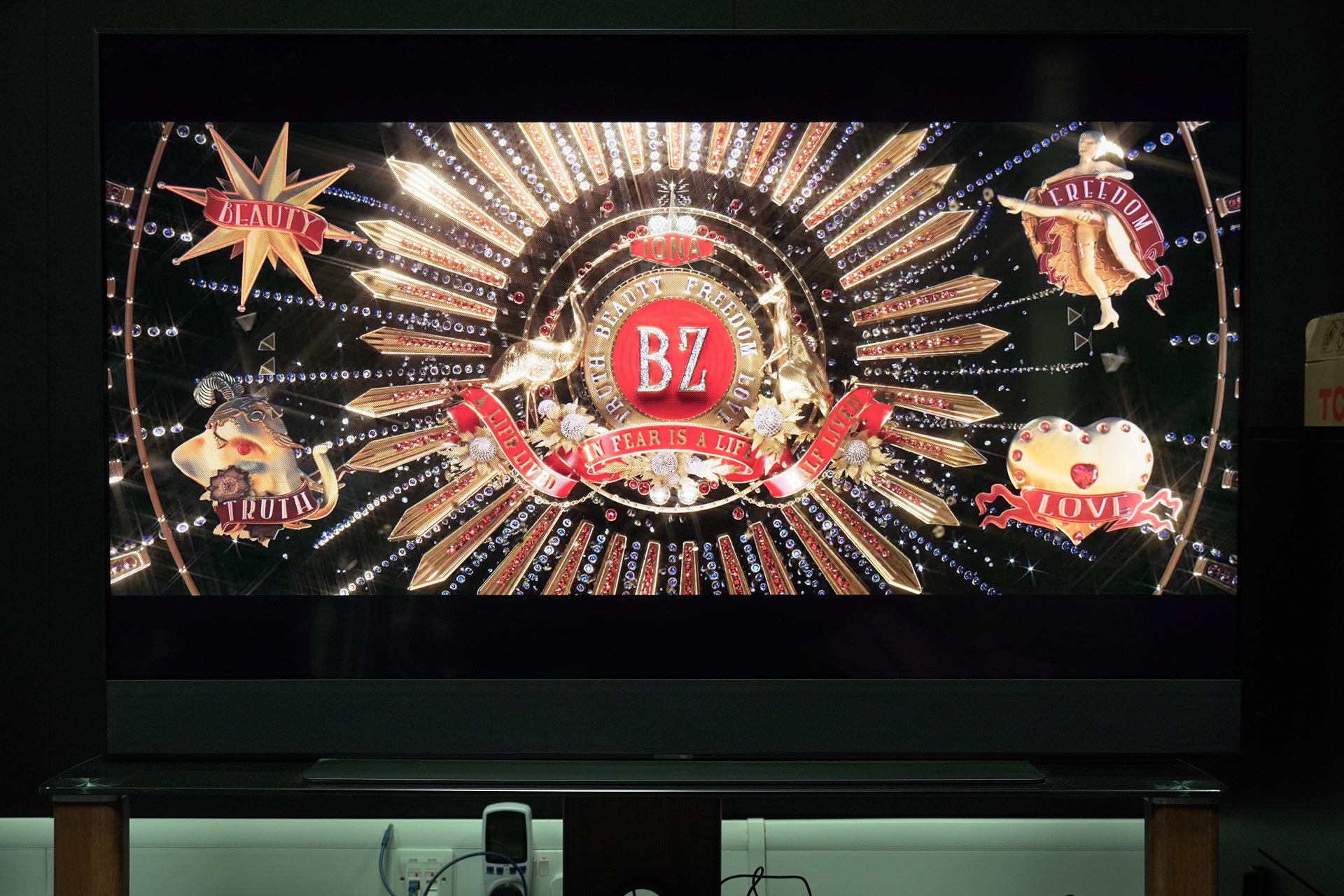

With Cinderella, black levels have more depth, complexions are amped up too (they look more natural). Colours are better represented over the rather dull look of the Movie and Entertainment modes. I’d describe the Movie preset as the most accurate and the Vivid mode as the most entertaining.


There’s less blooming noticeable in Vivid mode too, though the problem hasn’t completely gone away. There are still traces of it in the opening scene of House of the Dragon’s first episode that continue into the credits, and the visibility of the blooming depends on where you’re sitting (at wider angles it’s more noticeable).
But there’s only so much the Vivid mode can improve on what’s a below par QLED panel and backlight.


Black levels are inconsistent. Black uniformity is fine in Doctor Sleep, avoiding a washed-out appearance and boasting a decent level of depth but dark scenes from Dune, House of the Dragon, and The Penguin have a green tint to them. Move slightly off axis and the picture looks really poor. Black levels recede and colours fade. The only way to watch this TV is from head-on.
A strength of LCD TVs is dark detail and Sky Glass handles that aspect well enough, though this is more apparent with brighter images. And from head-on Glass does boast colourful and clear 4K images. More detail and sharpness would be nice, but like many QLED TVs, there’s a lightness and variety to shades that’s not too shabby when viewing Civil War on the TV.


However, with every bit of praise there’s a caveat.
With Blade Runner 2049 there’s banding (stripes of colour), dirty screen effect (DSE) and discolouration noticeable. The screen doesn’t deal well with reflections and glare, especially with dark scenes. Motion handling isn’t the most adept either, with a slight blurriness noticeable when people turn their heads.


HD streaming/upscaling is decent, at times sharp and clear enough to pick out fine detail but other times it’s soft with a distracting shininess to edges. Reducing sharpness helps but finding a middle ground is tricky. Sky Glass’ biggest problem is its inconsistency. Sometimes it looks fine, other times it is weak. Watching it a few years on from its release and the picture is very much showing its age.
Sound Quality
- Punchy bass
- Decent height effects
- A soundbar would offer better focus
Sky Glass’ 215W Dolby Atmos system features six speakers: three that fire audio forwards, two upfiring and a woofer for the low frequencies. It’s a spacious and loud presentation.


Vocals are main priority, though not quite always described naturally. Pump up the volume and voices (especially male ones) become slightly harder in tone but avoid sibilance. The effect of the Enhance Speech Quality setting is most evident on Sky content, with voices more prominent but the naturalness of the delivery stifled.
Effects are and positioned and steered across the screen well, creating a soundfield that spreads beyond the TV and with Atmos there’s height to the Glass’ soundstage in Blade Runner 2049 as Spinner cars and futuristic advertisements sit above and around the TV.


High frequencies have clarity (if not sharpness), and bass is punchy though lacks real low-end authority in a film such as Civil War, with impact sounds (gunshots) lacking some depth and power. There’s a decent naturalism about how it sounds, along with a decent sense of dynamism too.
I would still say that an Atmos soundbar is a better solution but Glass’ built-in sound system is a better effort than most TVs around its price.
Latest deals
Should you buy it?
For Sky customers who want a simplified TV experience
Sky Glass makes it easy for those who find buying a TV a complicated process. The sound system is decent and there’s all the content available from Sky and its partners
If you are after best picture
The picture remains Glass’ most disappointing aspect. The Vivid mode brings improvements but viewing angles are weak, black levels inconsistent and it lacks brightness with HDR content
Final Thoughts
Sky Glass gets a few things right. The interface is excellent, the sound system is quite decent too; and its picture is fine – as long as you don’t move your head about too much.
Arguably where it falters the most is with the most important aspect of a TV: picture quality. It lacks brightness for HDR content, and it isn’t as colourful as similarly priced TVs such as the Samsung Q80D or Hisense U7N. The Vivid mode is an improvement, enough that Sky Glass gets a recommendation but there are more capable HDR TVs.
Sky Live is interesting but best tailored to families. And it’s not as if Sky’s TV packages are inexpensive either. Add everything up and the bills pile up. A cheaper option would be to add Sky Stream to an existing TV. I can see what Sky was aiming for with Glass but its picture performance is showing its age a few years on from launch.
Here’s hoping that if there’s a Glass 2, Sky ups the ante with its picture performance. Then we could really be talking about one of the best TVs.
How we test
We test every television we review thoroughly over an extended period of time. We use industry standard tests to compare features properly. We’ll always tell you what we find. We never, ever, accept money to review a product.
Find out more about how we test in our ethics policy.
Tested with real world use
Benchmarked with Spears and Munsil test disc
Gaming input lag measured
FAQs
Sky says a minimum of 10Mb/s is required for the Glass TV. Minimum download speed for UHD is 25Mb/s.
Yes, without a Sky Ultimate TV subscription, your Sky Glass TV will work like a normal TV. You can hook the TV up to other devices like games consoles or DVD players via HDMI. You can even connect it to an aerial for Freeview TV.
Trusted Reviews test data
Input lag (ms)
Peak brightness (nits) 5%
Peak brightness (nits) 10%
›
UK RRP
USA RRP
EU RRP
CA RRP
AUD RRP
Manufacturer
Screen Size
Size (Dimensions)
Size (Dimensions without stand)
Weight
Operating System
Release Date
Resolution
HDR
Types of HDR
Refresh Rate TVs
Ports
HDMI (2.1)
Audio (Power output)
Connectivity
Colours
Display Technology
›
Jargon buster
QLED
QLED stands for Quantum-dot Light Emitting Diode. It’s a display technology that uses small particles (called Quantum Dots) made up of slightly different sizes that produce different wavelengths (colours) when light is shone through them. This filter helps to emit a brighter and wider gamut of colours than a conventional LED TV is capable of.
Dolby Vision
Dolby Vision is a variant of HDR, adding a layer of dynamic metadata to the core HDR signal. This dynamic metadata carries scene-by-scene (or frame-by-frame) instructions from content creators on how a TV should present the images to improve everything from brightness to contrast, detailing and colour reproduction.
4K Ultra HD TV
4K (or Ultra HD) refers to the resolution of a TV’s display, which equates to the number of horizontal and vertical pixels that it can display. 4K TVs have a resolution of 3840 x 2160 (8.3 million pixels), which is four times that of a Full HD TV. With more pixels, you get a sharper, clearer picture than is possible from an equivalent sized 1080p display.
Dolby Atmos
Dolby Atmos is an object-based audio format. It expands on 5.1 and 7.1 soundtracks by adding overhead channels. Sounds are referred to as “audio objects”, of which there can be up to 128 audio channels, and these ‘objects’ can be accurately positioned within a 3D soundscape. This allows soundtracks that support the technology to place sounds above and around the listener with compatible kit.
